Leadership and Communication: Thomas Edison's Leadership Style
VerifiedAdded on 2022/09/15
|17
|2357
|20
Report
AI Summary
This report delves into the leadership style of Thomas Edison, examining his key traits such as persistence, teamwork, and commitment to duty within the context of engineering communication and leadership. The report explores Edison's application of charismatic and contingency leadership theories, highlighting how he motivated and influenced others. It investigates his approach to team building, communication, and achieving organizational goals. The report further analyzes the contingency leadership model, discussing its situational factors and how it relates to Edison's leadership. The report concludes by summarizing Edison's leadership effectiveness, which is a result of his ability to adapt to various situations, ultimately inspiring employees to perform better. The report draws upon various sources, including biographical information and leadership theories, to provide a comprehensive analysis of Edison's impact on the industry.
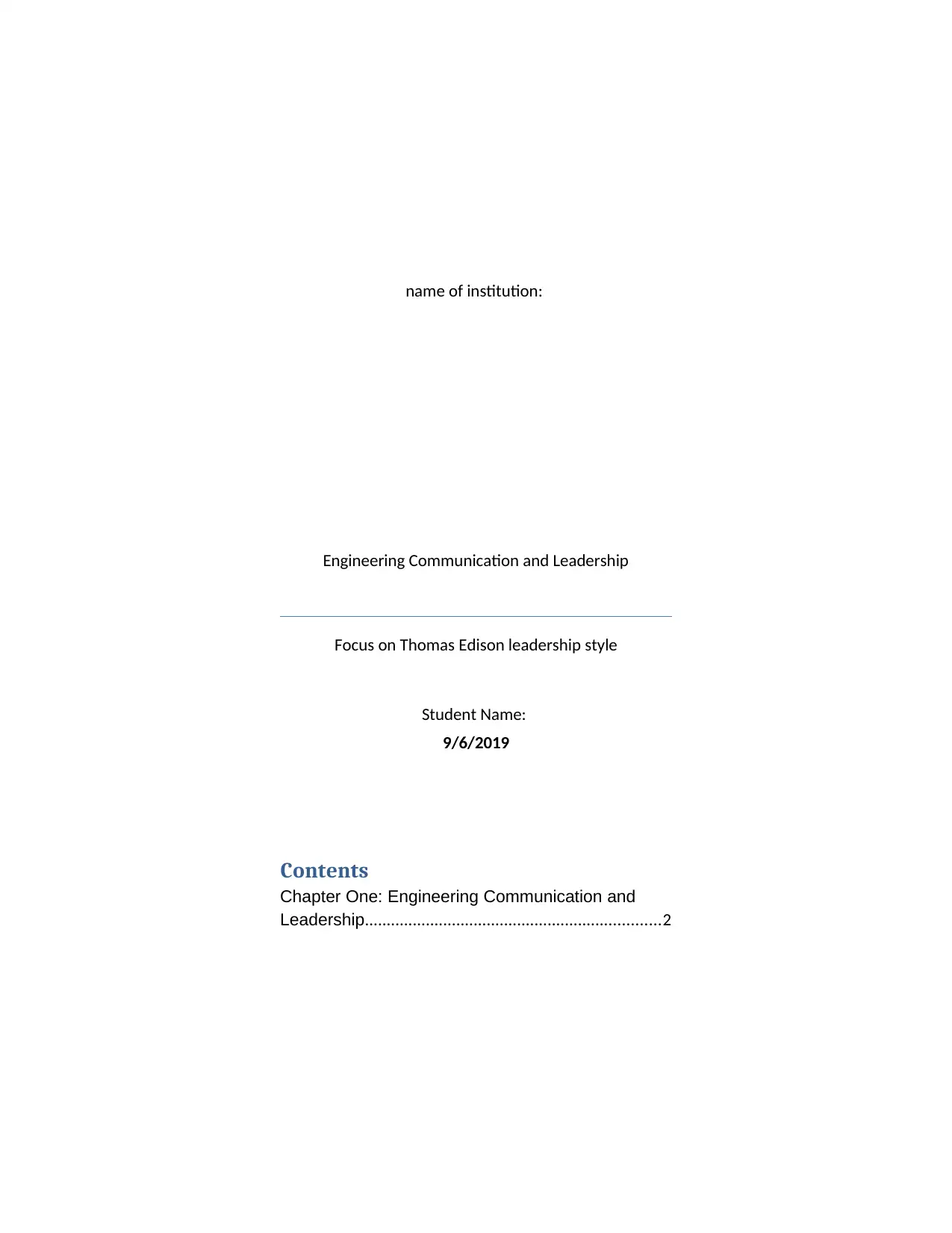
name of institution:
Engineering Communication and Leadership
Focus on Thomas Edison leadership style
Student Name:
9/6/2019
Contents
Chapter One: Engineering Communication and
Leadership....................................................................2
Engineering Communication and Leadership
Focus on Thomas Edison leadership style
Student Name:
9/6/2019
Contents
Chapter One: Engineering Communication and
Leadership....................................................................2
Paraphrase This Document
Need a fresh take? Get an instant paraphrase of this document with our AI Paraphraser
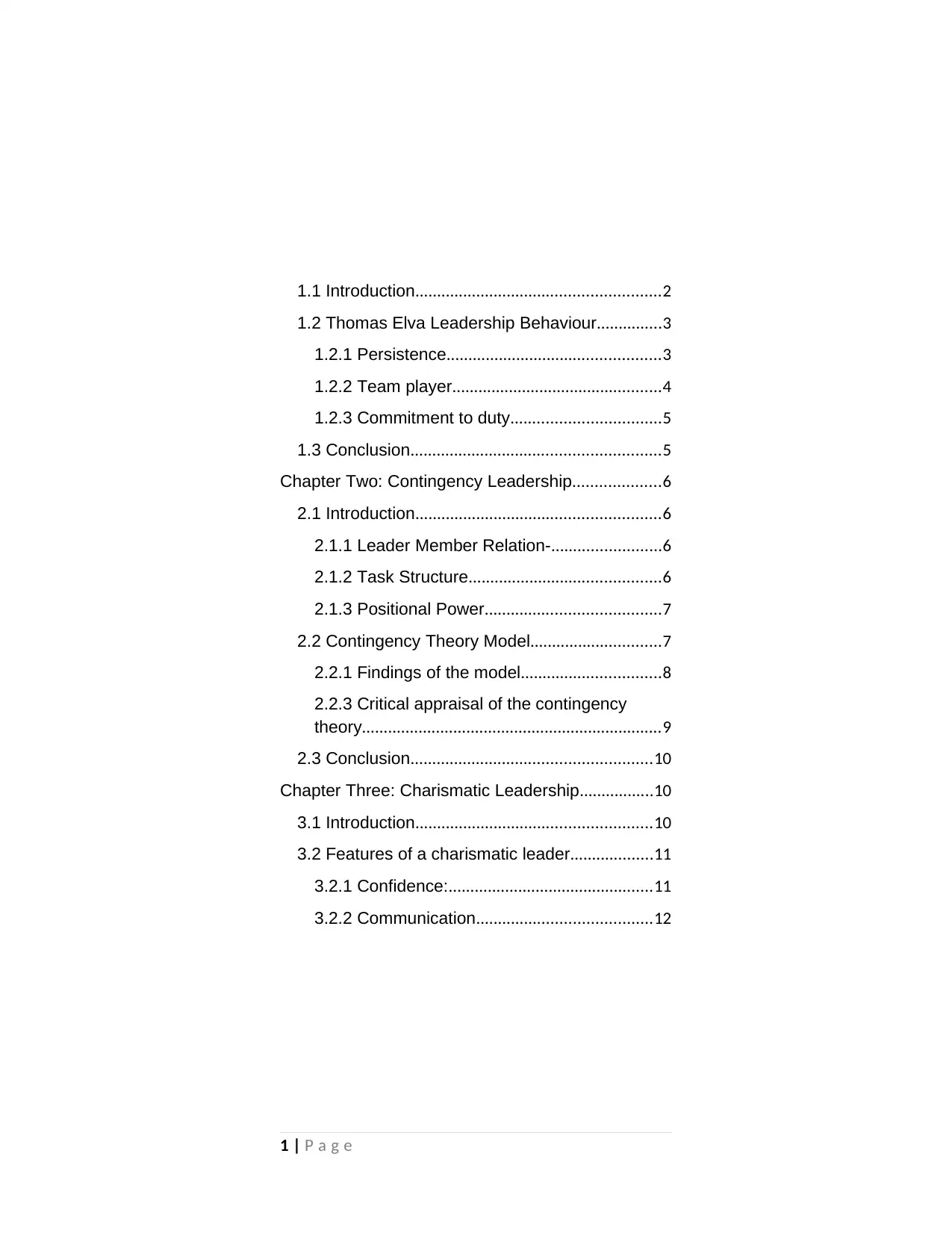
1.1 Introduction........................................................2
1.2 Thomas Elva Leadership Behaviour...............3
1.2.1 Persistence.................................................3
1.2.2 Team player................................................4
1.2.3 Commitment to duty..................................5
1.3 Conclusion.........................................................5
Chapter Two: Contingency Leadership....................6
2.1 Introduction........................................................6
2.1.1 Leader Member Relation-.........................6
2.1.2 Task Structure............................................6
2.1.3 Positional Power........................................7
2.2 Contingency Theory Model..............................7
2.2.1 Findings of the model................................8
2.2.3 Critical appraisal of the contingency
theory.....................................................................9
2.3 Conclusion.......................................................10
Chapter Three: Charismatic Leadership.................10
3.1 Introduction......................................................10
3.2 Features of a charismatic leader...................11
3.2.1 Confidence:...............................................11
3.2.2 Communication........................................12
1 | P a g e
1.2 Thomas Elva Leadership Behaviour...............3
1.2.1 Persistence.................................................3
1.2.2 Team player................................................4
1.2.3 Commitment to duty..................................5
1.3 Conclusion.........................................................5
Chapter Two: Contingency Leadership....................6
2.1 Introduction........................................................6
2.1.1 Leader Member Relation-.........................6
2.1.2 Task Structure............................................6
2.1.3 Positional Power........................................7
2.2 Contingency Theory Model..............................7
2.2.1 Findings of the model................................8
2.2.3 Critical appraisal of the contingency
theory.....................................................................9
2.3 Conclusion.......................................................10
Chapter Three: Charismatic Leadership.................10
3.1 Introduction......................................................10
3.2 Features of a charismatic leader...................11
3.2.1 Confidence:...............................................11
3.2.2 Communication........................................12
1 | P a g e
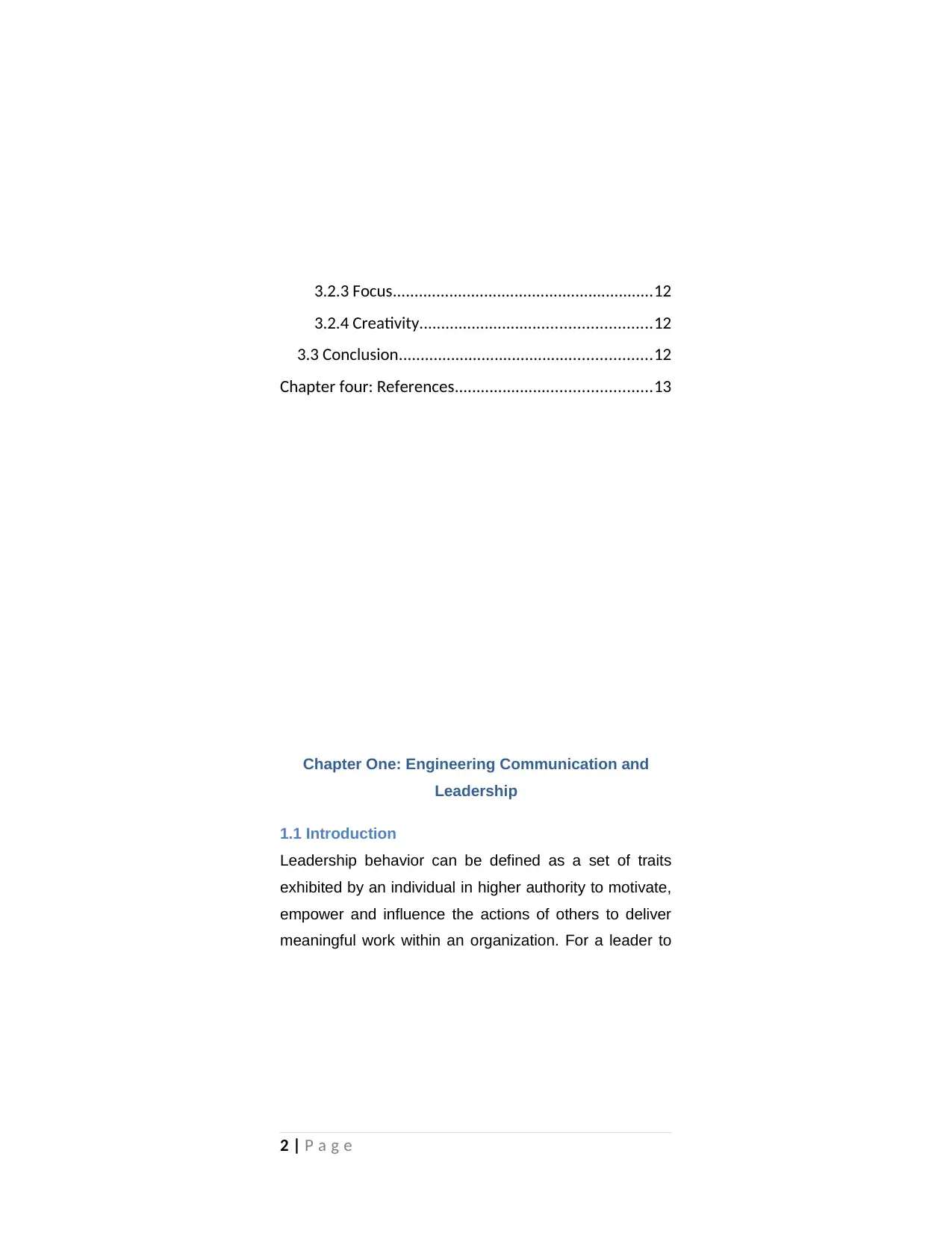
3.2.3 Focus............................................................12
3.2.4 Creativity.....................................................12
3.3 Conclusion..........................................................12
Chapter four: References.............................................13
Chapter One: Engineering Communication and
Leadership
1.1 Introduction
Leadership behavior can be defined as a set of traits
exhibited by an individual in higher authority to motivate,
empower and influence the actions of others to deliver
meaningful work within an organization. For a leader to
2 | P a g e
3.2.4 Creativity.....................................................12
3.3 Conclusion..........................................................12
Chapter four: References.............................................13
Chapter One: Engineering Communication and
Leadership
1.1 Introduction
Leadership behavior can be defined as a set of traits
exhibited by an individual in higher authority to motivate,
empower and influence the actions of others to deliver
meaningful work within an organization. For a leader to
2 | P a g e
⊘ This is a preview!⊘
Do you want full access?
Subscribe today to unlock all pages.

Trusted by 1+ million students worldwide
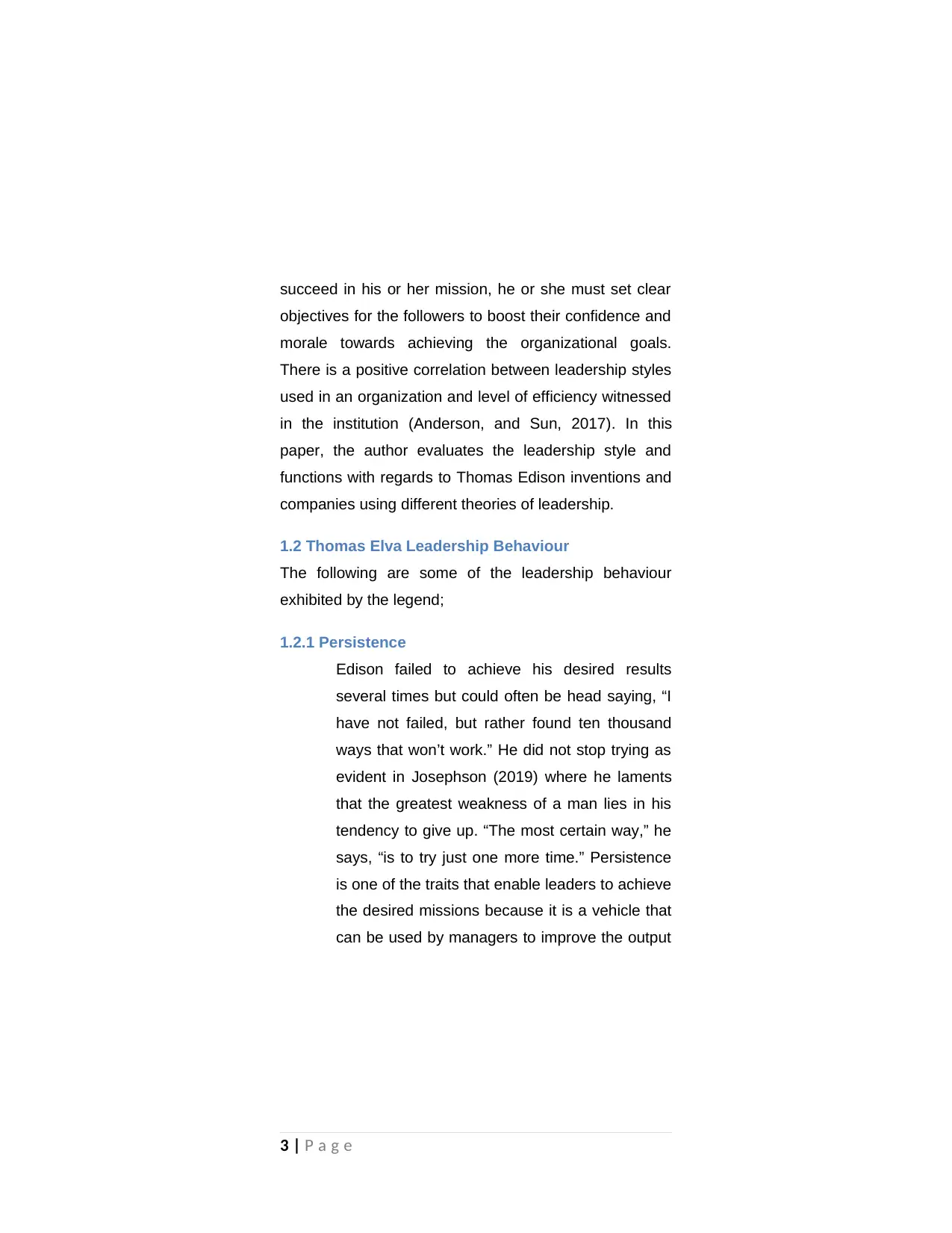
succeed in his or her mission, he or she must set clear
objectives for the followers to boost their confidence and
morale towards achieving the organizational goals.
There is a positive correlation between leadership styles
used in an organization and level of efficiency witnessed
in the institution (Anderson, and Sun, 2017). In this
paper, the author evaluates the leadership style and
functions with regards to Thomas Edison inventions and
companies using different theories of leadership.
1.2 Thomas Elva Leadership Behaviour
The following are some of the leadership behaviour
exhibited by the legend;
1.2.1 Persistence
Edison failed to achieve his desired results
several times but could often be head saying, “I
have not failed, but rather found ten thousand
ways that won’t work.” He did not stop trying as
evident in Josephson (2019) where he laments
that the greatest weakness of a man lies in his
tendency to give up. “The most certain way,” he
says, “is to try just one more time.” Persistence
is one of the traits that enable leaders to achieve
the desired missions because it is a vehicle that
can be used by managers to improve the output
3 | P a g e
objectives for the followers to boost their confidence and
morale towards achieving the organizational goals.
There is a positive correlation between leadership styles
used in an organization and level of efficiency witnessed
in the institution (Anderson, and Sun, 2017). In this
paper, the author evaluates the leadership style and
functions with regards to Thomas Edison inventions and
companies using different theories of leadership.
1.2 Thomas Elva Leadership Behaviour
The following are some of the leadership behaviour
exhibited by the legend;
1.2.1 Persistence
Edison failed to achieve his desired results
several times but could often be head saying, “I
have not failed, but rather found ten thousand
ways that won’t work.” He did not stop trying as
evident in Josephson (2019) where he laments
that the greatest weakness of a man lies in his
tendency to give up. “The most certain way,” he
says, “is to try just one more time.” Persistence
is one of the traits that enable leaders to achieve
the desired missions because it is a vehicle that
can be used by managers to improve the output
3 | P a g e
Paraphrase This Document
Need a fresh take? Get an instant paraphrase of this document with our AI Paraphraser
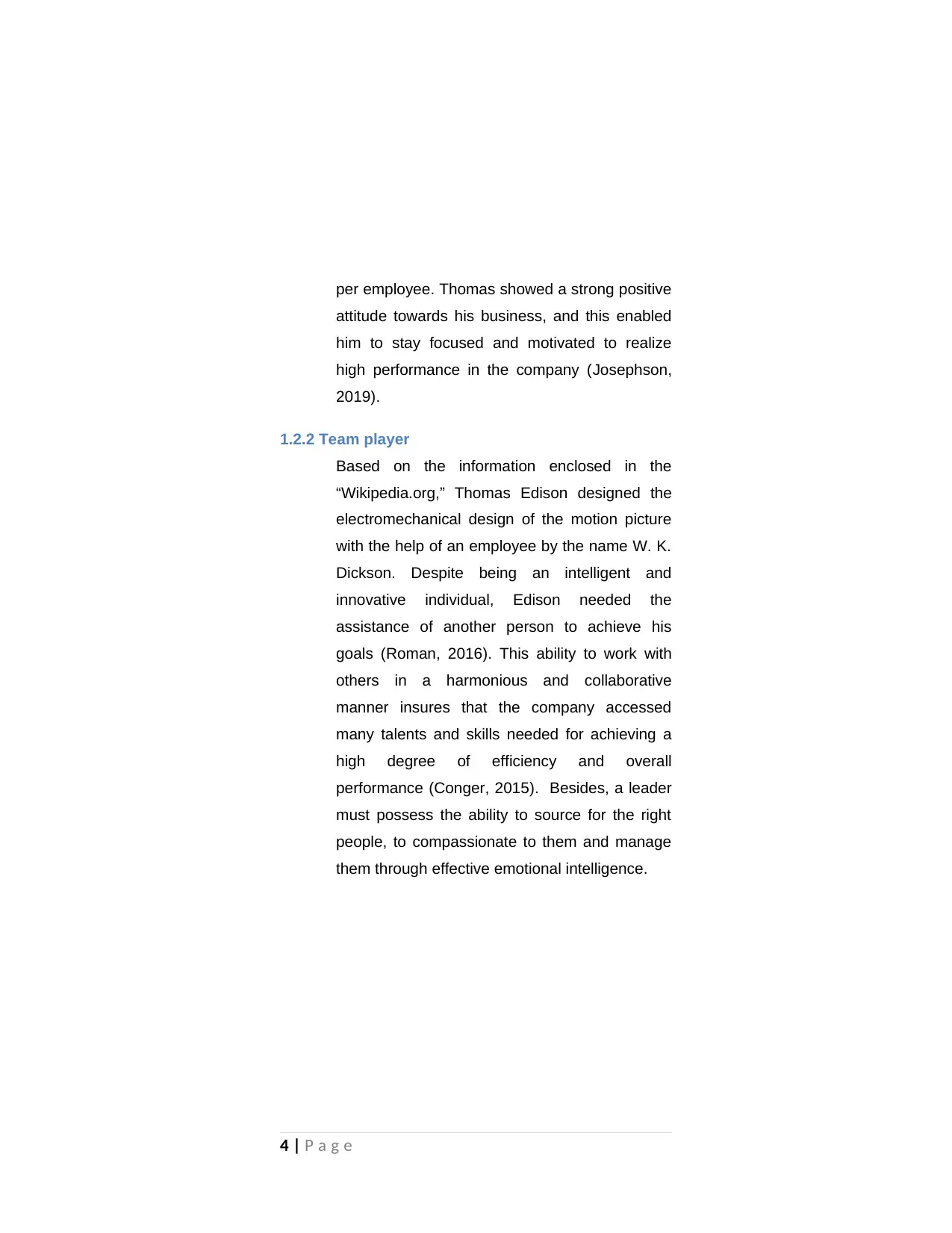
per employee. Thomas showed a strong positive
attitude towards his business, and this enabled
him to stay focused and motivated to realize
high performance in the company (Josephson,
2019).
1.2.2 Team player
Based on the information enclosed in the
“Wikipedia.org,” Thomas Edison designed the
electromechanical design of the motion picture
with the help of an employee by the name W. K.
Dickson. Despite being an intelligent and
innovative individual, Edison needed the
assistance of another person to achieve his
goals (Roman, 2016). This ability to work with
others in a harmonious and collaborative
manner insures that the company accessed
many talents and skills needed for achieving a
high degree of efficiency and overall
performance (Conger, 2015). Besides, a leader
must possess the ability to source for the right
people, to compassionate to them and manage
them through effective emotional intelligence.
4 | P a g e
attitude towards his business, and this enabled
him to stay focused and motivated to realize
high performance in the company (Josephson,
2019).
1.2.2 Team player
Based on the information enclosed in the
“Wikipedia.org,” Thomas Edison designed the
electromechanical design of the motion picture
with the help of an employee by the name W. K.
Dickson. Despite being an intelligent and
innovative individual, Edison needed the
assistance of another person to achieve his
goals (Roman, 2016). This ability to work with
others in a harmonious and collaborative
manner insures that the company accessed
many talents and skills needed for achieving a
high degree of efficiency and overall
performance (Conger, 2015). Besides, a leader
must possess the ability to source for the right
people, to compassionate to them and manage
them through effective emotional intelligence.
4 | P a g e
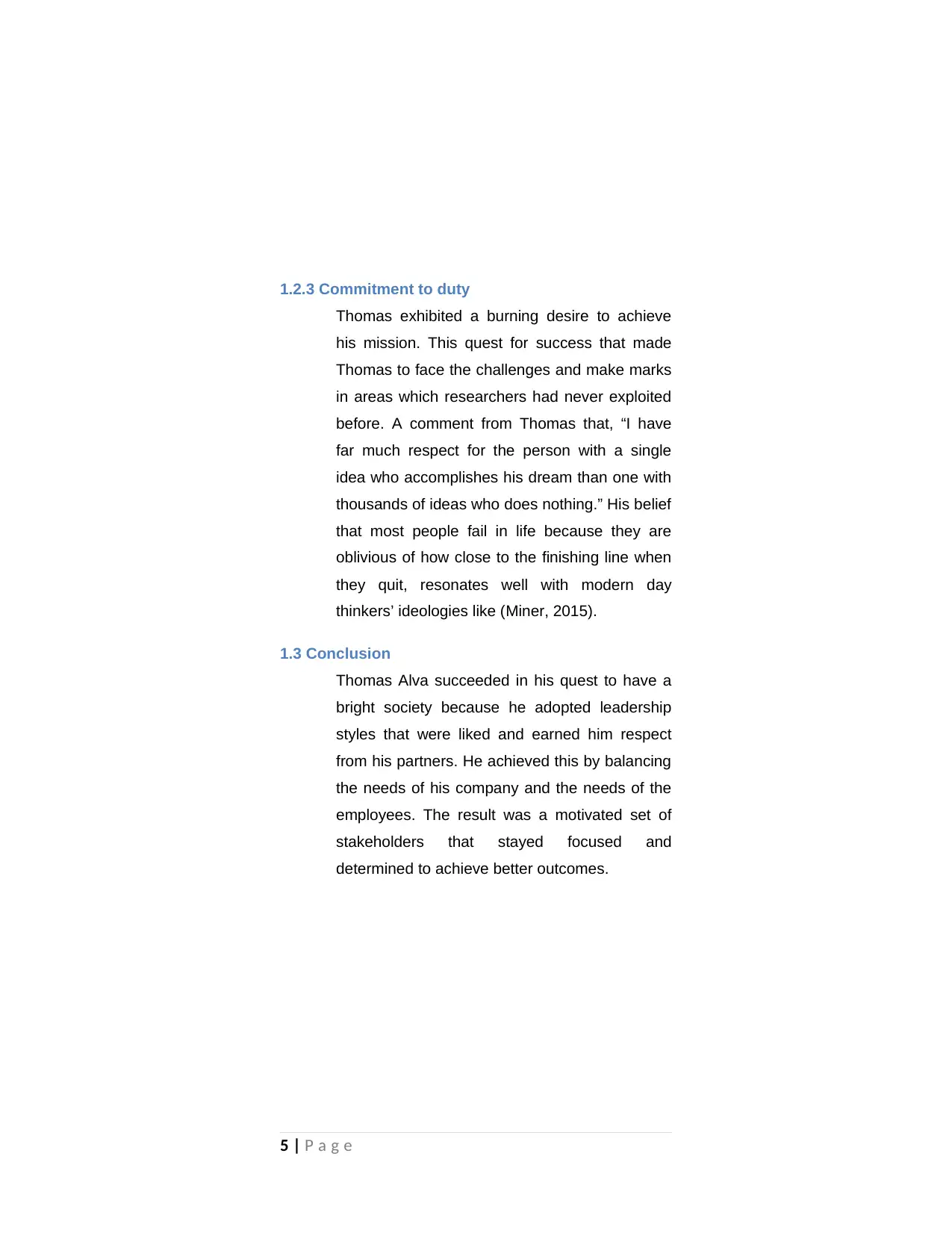
1.2.3 Commitment to duty
Thomas exhibited a burning desire to achieve
his mission. This quest for success that made
Thomas to face the challenges and make marks
in areas which researchers had never exploited
before. A comment from Thomas that, “I have
far much respect for the person with a single
idea who accomplishes his dream than one with
thousands of ideas who does nothing.” His belief
that most people fail in life because they are
oblivious of how close to the finishing line when
they quit, resonates well with modern day
thinkers’ ideologies like (Miner, 2015).
1.3 Conclusion
Thomas Alva succeeded in his quest to have a
bright society because he adopted leadership
styles that were liked and earned him respect
from his partners. He achieved this by balancing
the needs of his company and the needs of the
employees. The result was a motivated set of
stakeholders that stayed focused and
determined to achieve better outcomes.
5 | P a g e
Thomas exhibited a burning desire to achieve
his mission. This quest for success that made
Thomas to face the challenges and make marks
in areas which researchers had never exploited
before. A comment from Thomas that, “I have
far much respect for the person with a single
idea who accomplishes his dream than one with
thousands of ideas who does nothing.” His belief
that most people fail in life because they are
oblivious of how close to the finishing line when
they quit, resonates well with modern day
thinkers’ ideologies like (Miner, 2015).
1.3 Conclusion
Thomas Alva succeeded in his quest to have a
bright society because he adopted leadership
styles that were liked and earned him respect
from his partners. He achieved this by balancing
the needs of his company and the needs of the
employees. The result was a motivated set of
stakeholders that stayed focused and
determined to achieve better outcomes.
5 | P a g e
⊘ This is a preview!⊘
Do you want full access?
Subscribe today to unlock all pages.

Trusted by 1+ million students worldwide
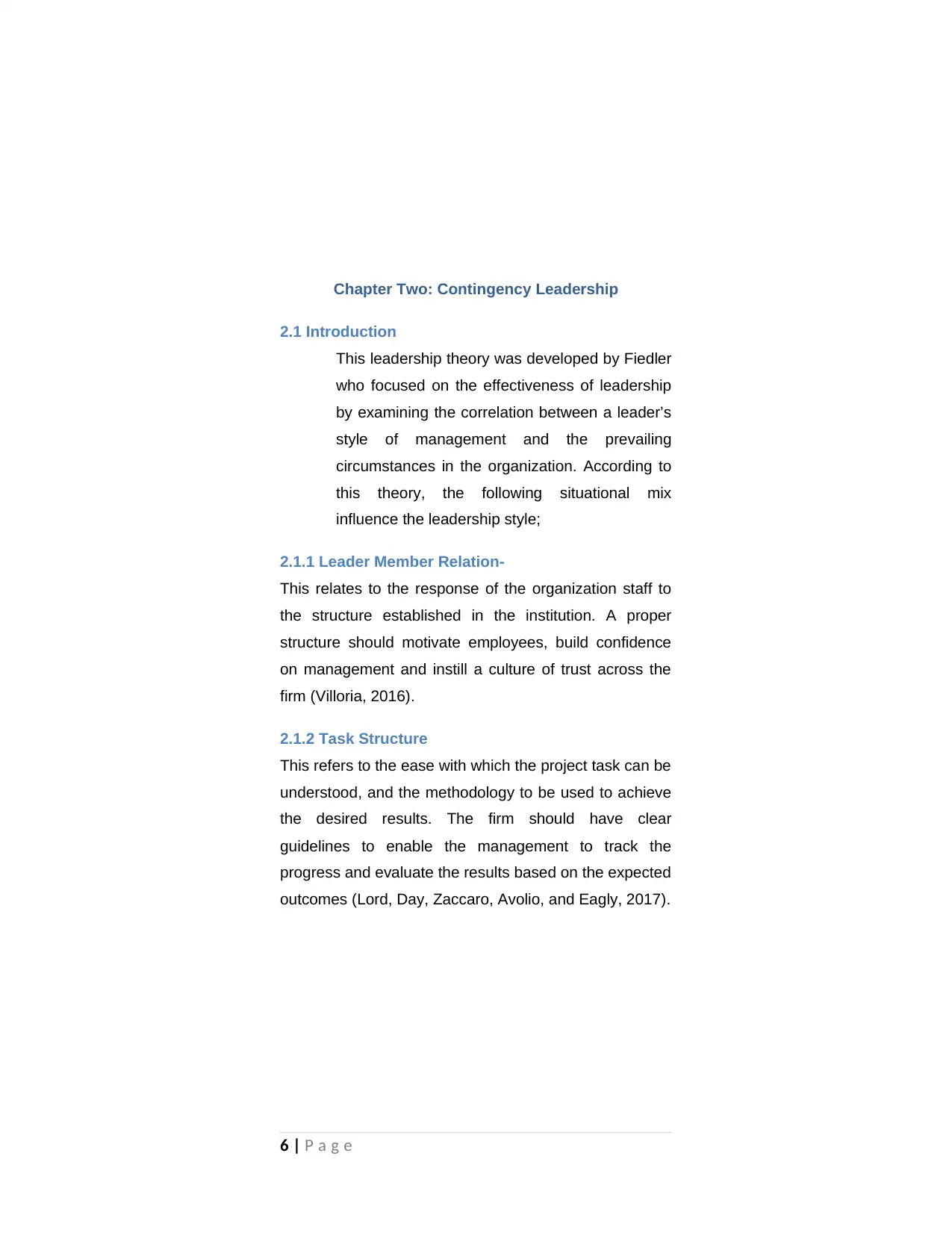
Chapter Two: Contingency Leadership
2.1 Introduction
This leadership theory was developed by Fiedler
who focused on the effectiveness of leadership
by examining the correlation between a leader’s
style of management and the prevailing
circumstances in the organization. According to
this theory, the following situational mix
influence the leadership style;
2.1.1 Leader Member Relation-
This relates to the response of the organization staff to
the structure established in the institution. A proper
structure should motivate employees, build confidence
on management and instill a culture of trust across the
firm (Villoria, 2016).
2.1.2 Task Structure
This refers to the ease with which the project task can be
understood, and the methodology to be used to achieve
the desired results. The firm should have clear
guidelines to enable the management to track the
progress and evaluate the results based on the expected
outcomes (Lord, Day, Zaccaro, Avolio, and Eagly, 2017).
6 | P a g e
2.1 Introduction
This leadership theory was developed by Fiedler
who focused on the effectiveness of leadership
by examining the correlation between a leader’s
style of management and the prevailing
circumstances in the organization. According to
this theory, the following situational mix
influence the leadership style;
2.1.1 Leader Member Relation-
This relates to the response of the organization staff to
the structure established in the institution. A proper
structure should motivate employees, build confidence
on management and instill a culture of trust across the
firm (Villoria, 2016).
2.1.2 Task Structure
This refers to the ease with which the project task can be
understood, and the methodology to be used to achieve
the desired results. The firm should have clear
guidelines to enable the management to track the
progress and evaluate the results based on the expected
outcomes (Lord, Day, Zaccaro, Avolio, and Eagly, 2017).
6 | P a g e
Paraphrase This Document
Need a fresh take? Get an instant paraphrase of this document with our AI Paraphraser
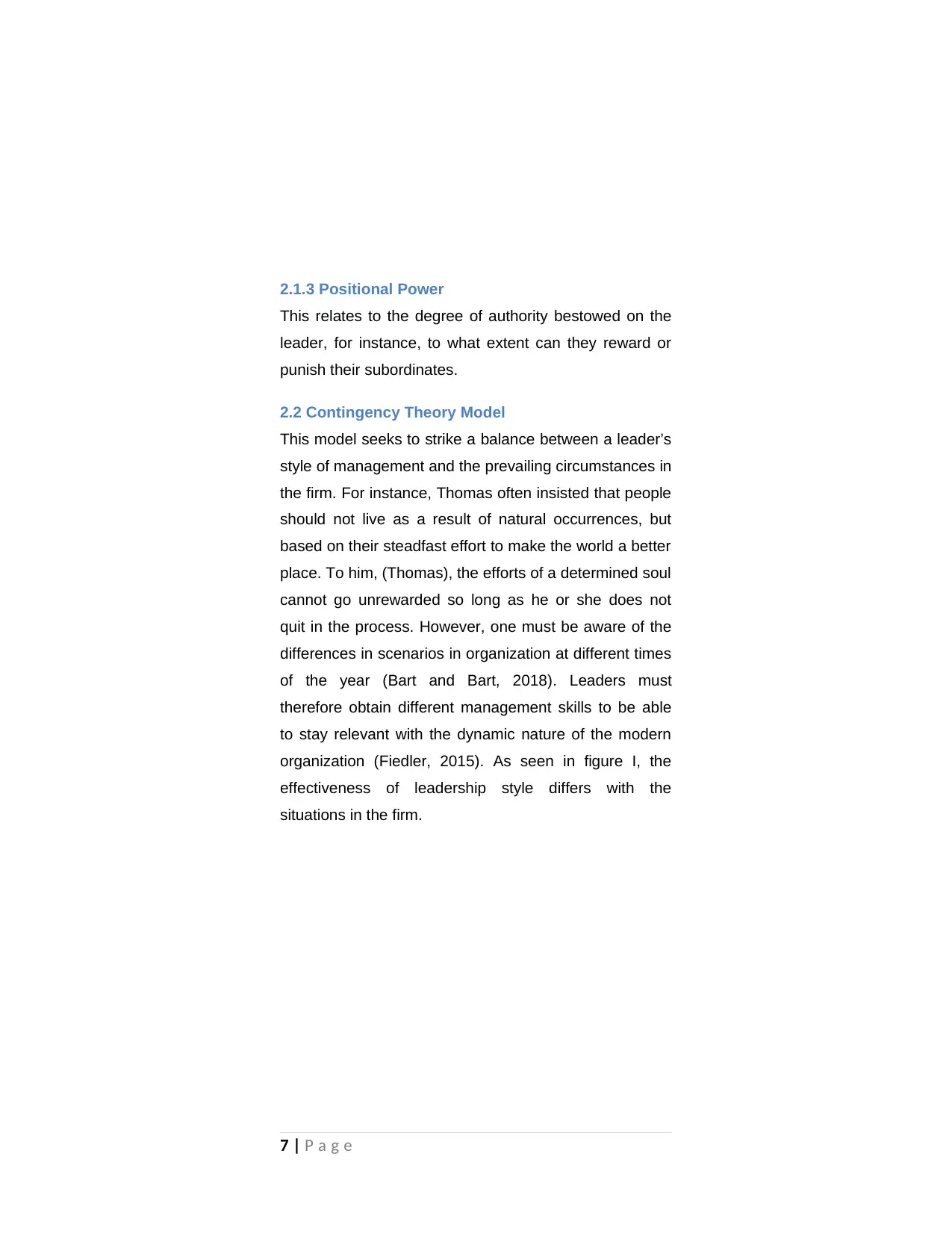
2.1.3 Positional Power
This relates to the degree of authority bestowed on the
leader, for instance, to what extent can they reward or
punish their subordinates.
2.2 Contingency Theory Model
This model seeks to strike a balance between a leader’s
style of management and the prevailing circumstances in
the firm. For instance, Thomas often insisted that people
should not live as a result of natural occurrences, but
based on their steadfast effort to make the world a better
place. To him, (Thomas), the efforts of a determined soul
cannot go unrewarded so long as he or she does not
quit in the process. However, one must be aware of the
differences in scenarios in organization at different times
of the year (Bart and Bart, 2018). Leaders must
therefore obtain different management skills to be able
to stay relevant with the dynamic nature of the modern
organization (Fiedler, 2015). As seen in figure I, the
effectiveness of leadership style differs with the
situations in the firm.
7 | P a g e
This relates to the degree of authority bestowed on the
leader, for instance, to what extent can they reward or
punish their subordinates.
2.2 Contingency Theory Model
This model seeks to strike a balance between a leader’s
style of management and the prevailing circumstances in
the firm. For instance, Thomas often insisted that people
should not live as a result of natural occurrences, but
based on their steadfast effort to make the world a better
place. To him, (Thomas), the efforts of a determined soul
cannot go unrewarded so long as he or she does not
quit in the process. However, one must be aware of the
differences in scenarios in organization at different times
of the year (Bart and Bart, 2018). Leaders must
therefore obtain different management skills to be able
to stay relevant with the dynamic nature of the modern
organization (Fiedler, 2015). As seen in figure I, the
effectiveness of leadership style differs with the
situations in the firm.
7 | P a g e
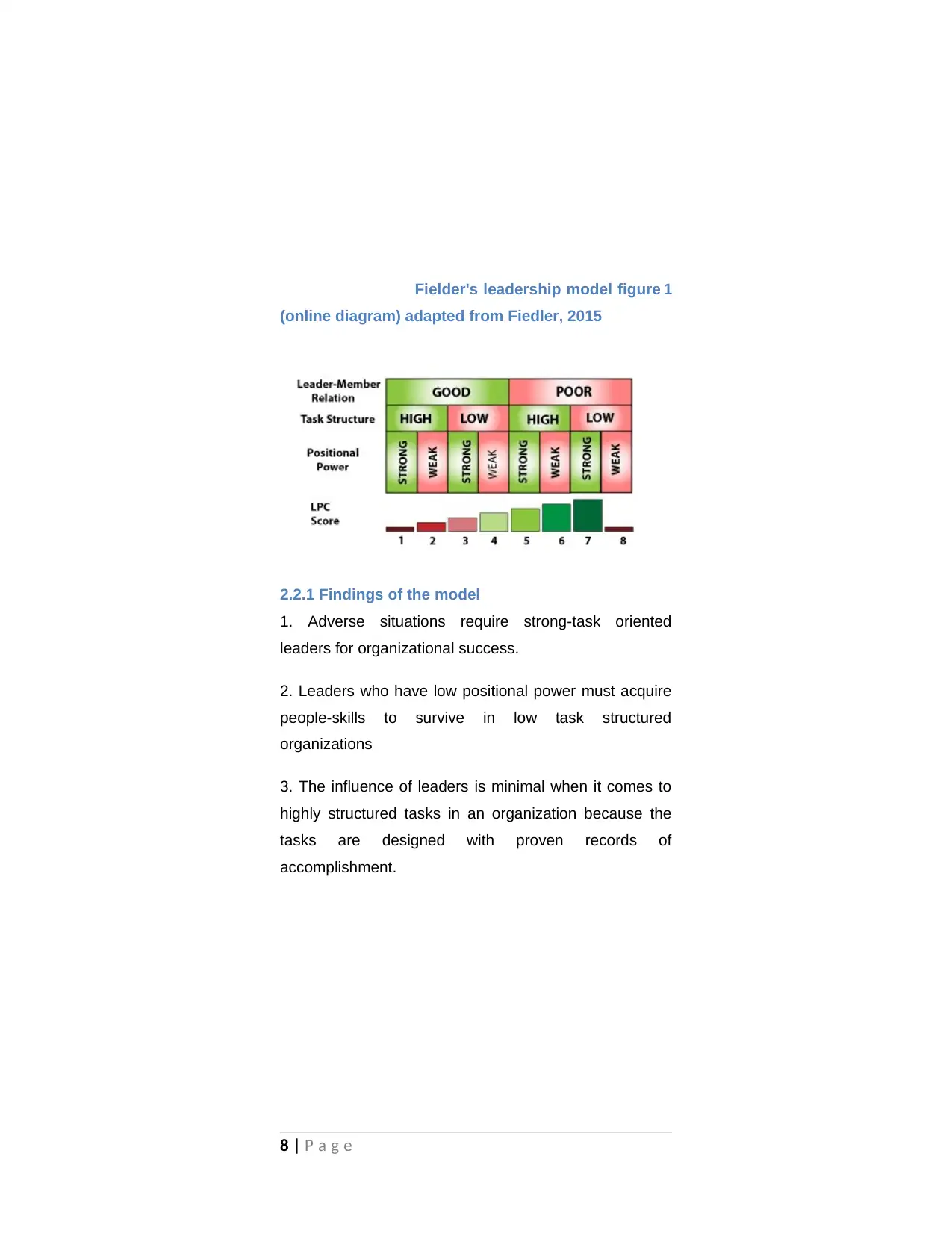
Fielder's leadership model figure 1
(online diagram) adapted from Fiedler, 2015
2.2.1 Findings of the model
1. Adverse situations require strong-task oriented
leaders for organizational success.
2. Leaders who have low positional power must acquire
people-skills to survive in low task structured
organizations
3. The influence of leaders is minimal when it comes to
highly structured tasks in an organization because the
tasks are designed with proven records of
accomplishment.
8 | P a g e
(online diagram) adapted from Fiedler, 2015
2.2.1 Findings of the model
1. Adverse situations require strong-task oriented
leaders for organizational success.
2. Leaders who have low positional power must acquire
people-skills to survive in low task structured
organizations
3. The influence of leaders is minimal when it comes to
highly structured tasks in an organization because the
tasks are designed with proven records of
accomplishment.
8 | P a g e
⊘ This is a preview!⊘
Do you want full access?
Subscribe today to unlock all pages.

Trusted by 1+ million students worldwide
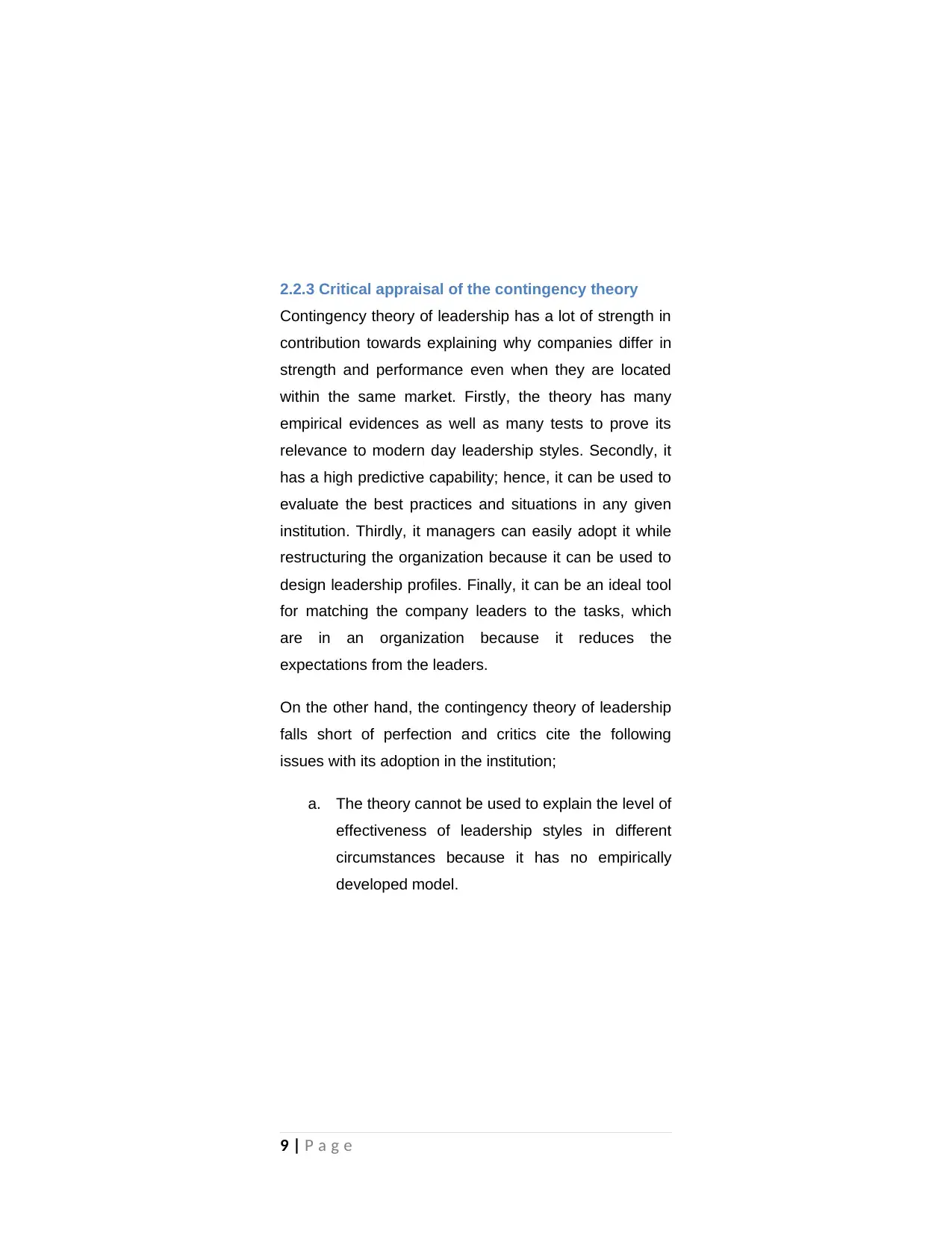
2.2.3 Critical appraisal of the contingency theory
Contingency theory of leadership has a lot of strength in
contribution towards explaining why companies differ in
strength and performance even when they are located
within the same market. Firstly, the theory has many
empirical evidences as well as many tests to prove its
relevance to modern day leadership styles. Secondly, it
has a high predictive capability; hence, it can be used to
evaluate the best practices and situations in any given
institution. Thirdly, it managers can easily adopt it while
restructuring the organization because it can be used to
design leadership profiles. Finally, it can be an ideal tool
for matching the company leaders to the tasks, which
are in an organization because it reduces the
expectations from the leaders.
On the other hand, the contingency theory of leadership
falls short of perfection and critics cite the following
issues with its adoption in the institution;
a. The theory cannot be used to explain the level of
effectiveness of leadership styles in different
circumstances because it has no empirically
developed model.
9 | P a g e
Contingency theory of leadership has a lot of strength in
contribution towards explaining why companies differ in
strength and performance even when they are located
within the same market. Firstly, the theory has many
empirical evidences as well as many tests to prove its
relevance to modern day leadership styles. Secondly, it
has a high predictive capability; hence, it can be used to
evaluate the best practices and situations in any given
institution. Thirdly, it managers can easily adopt it while
restructuring the organization because it can be used to
design leadership profiles. Finally, it can be an ideal tool
for matching the company leaders to the tasks, which
are in an organization because it reduces the
expectations from the leaders.
On the other hand, the contingency theory of leadership
falls short of perfection and critics cite the following
issues with its adoption in the institution;
a. The theory cannot be used to explain the level of
effectiveness of leadership styles in different
circumstances because it has no empirically
developed model.
9 | P a g e
Paraphrase This Document
Need a fresh take? Get an instant paraphrase of this document with our AI Paraphraser
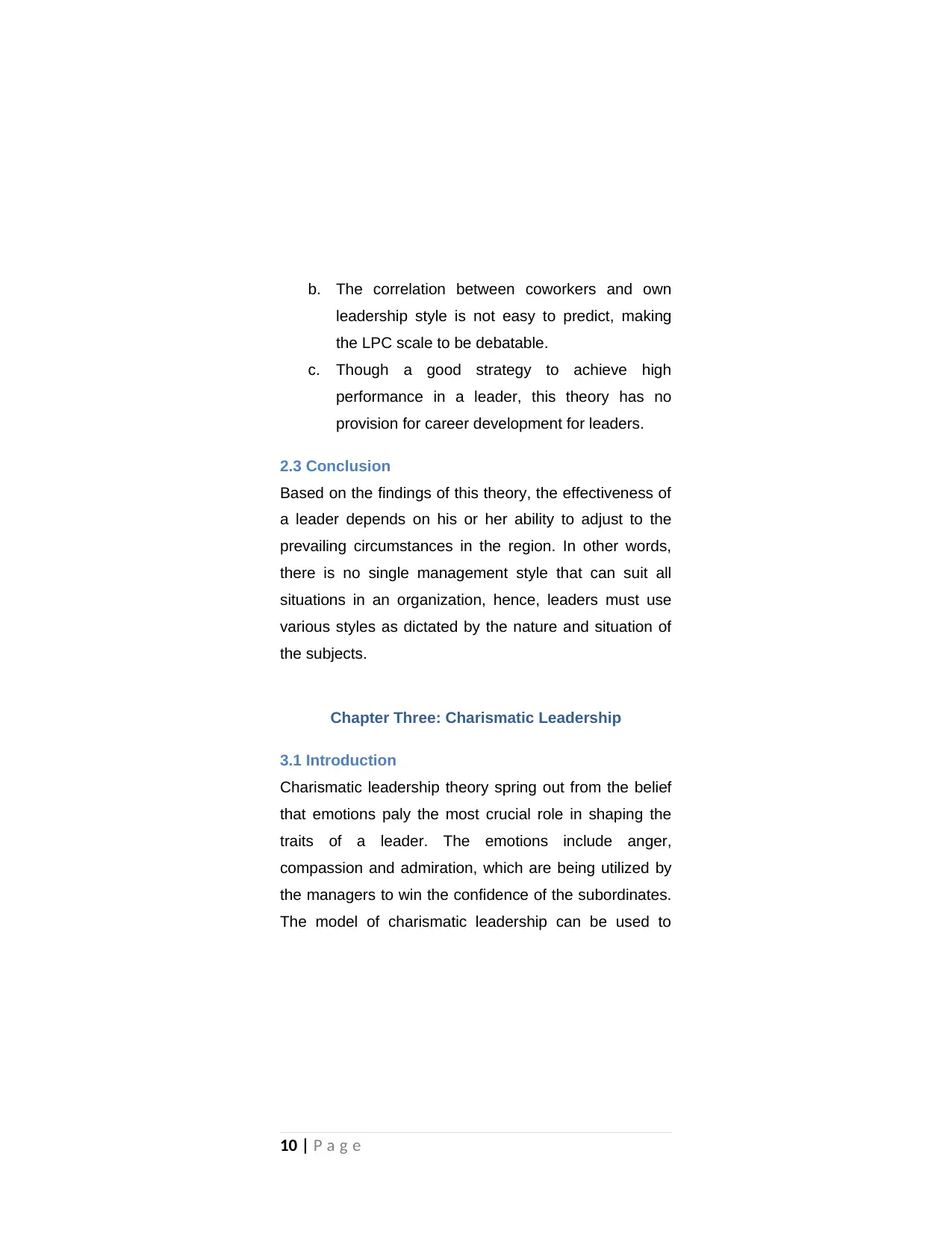
b. The correlation between coworkers and own
leadership style is not easy to predict, making
the LPC scale to be debatable.
c. Though a good strategy to achieve high
performance in a leader, this theory has no
provision for career development for leaders.
2.3 Conclusion
Based on the findings of this theory, the effectiveness of
a leader depends on his or her ability to adjust to the
prevailing circumstances in the region. In other words,
there is no single management style that can suit all
situations in an organization, hence, leaders must use
various styles as dictated by the nature and situation of
the subjects.
Chapter Three: Charismatic Leadership
3.1 Introduction
Charismatic leadership theory spring out from the belief
that emotions paly the most crucial role in shaping the
traits of a leader. The emotions include anger,
compassion and admiration, which are being utilized by
the managers to win the confidence of the subordinates.
The model of charismatic leadership can be used to
10 | P a g e
leadership style is not easy to predict, making
the LPC scale to be debatable.
c. Though a good strategy to achieve high
performance in a leader, this theory has no
provision for career development for leaders.
2.3 Conclusion
Based on the findings of this theory, the effectiveness of
a leader depends on his or her ability to adjust to the
prevailing circumstances in the region. In other words,
there is no single management style that can suit all
situations in an organization, hence, leaders must use
various styles as dictated by the nature and situation of
the subjects.
Chapter Three: Charismatic Leadership
3.1 Introduction
Charismatic leadership theory spring out from the belief
that emotions paly the most crucial role in shaping the
traits of a leader. The emotions include anger,
compassion and admiration, which are being utilized by
the managers to win the confidence of the subordinates.
The model of charismatic leadership can be used to
10 | P a g e
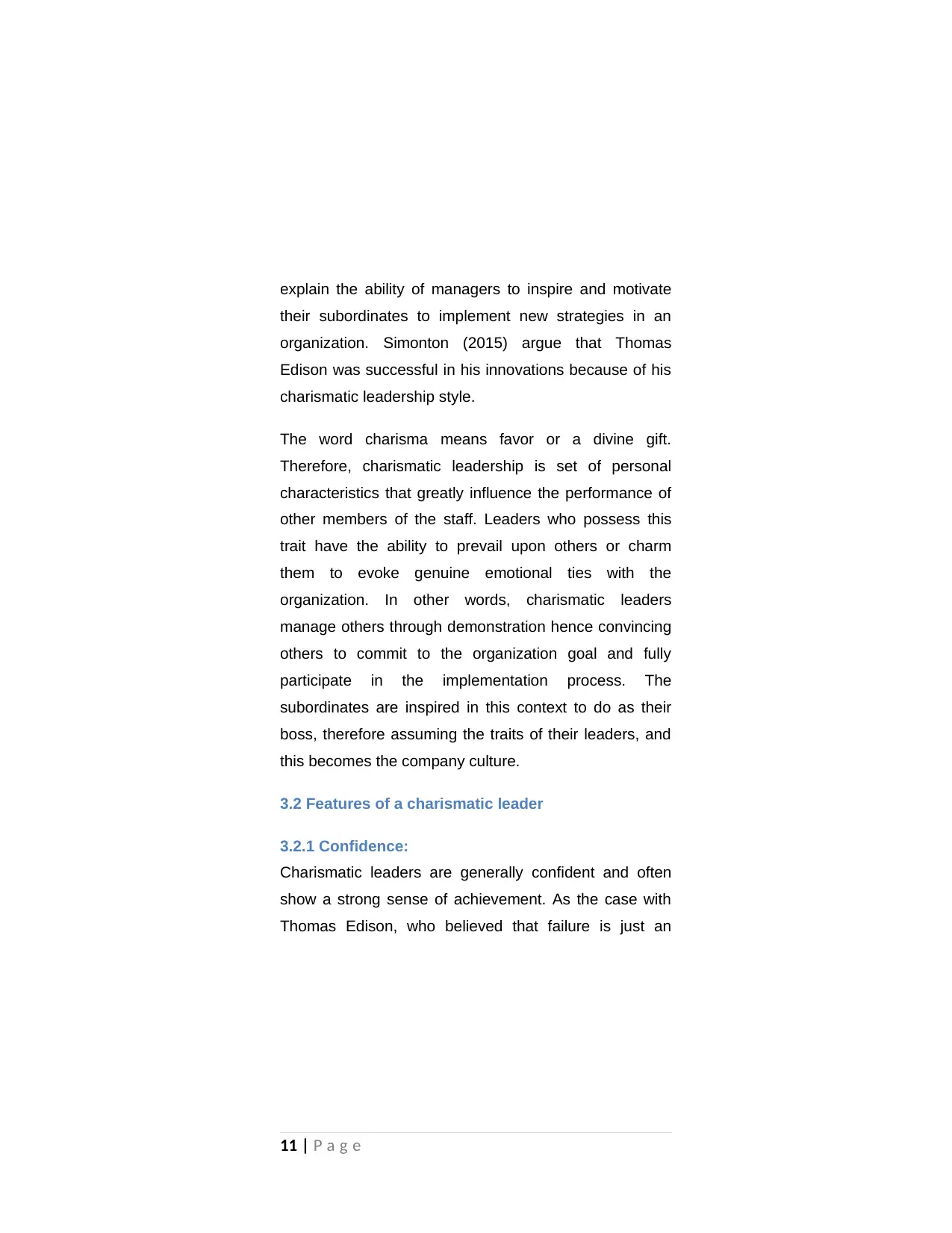
explain the ability of managers to inspire and motivate
their subordinates to implement new strategies in an
organization. Simonton (2015) argue that Thomas
Edison was successful in his innovations because of his
charismatic leadership style.
The word charisma means favor or a divine gift.
Therefore, charismatic leadership is set of personal
characteristics that greatly influence the performance of
other members of the staff. Leaders who possess this
trait have the ability to prevail upon others or charm
them to evoke genuine emotional ties with the
organization. In other words, charismatic leaders
manage others through demonstration hence convincing
others to commit to the organization goal and fully
participate in the implementation process. The
subordinates are inspired in this context to do as their
boss, therefore assuming the traits of their leaders, and
this becomes the company culture.
3.2 Features of a charismatic leader
3.2.1 Confidence:
Charismatic leaders are generally confident and often
show a strong sense of achievement. As the case with
Thomas Edison, who believed that failure is just an
11 | P a g e
their subordinates to implement new strategies in an
organization. Simonton (2015) argue that Thomas
Edison was successful in his innovations because of his
charismatic leadership style.
The word charisma means favor or a divine gift.
Therefore, charismatic leadership is set of personal
characteristics that greatly influence the performance of
other members of the staff. Leaders who possess this
trait have the ability to prevail upon others or charm
them to evoke genuine emotional ties with the
organization. In other words, charismatic leaders
manage others through demonstration hence convincing
others to commit to the organization goal and fully
participate in the implementation process. The
subordinates are inspired in this context to do as their
boss, therefore assuming the traits of their leaders, and
this becomes the company culture.
3.2 Features of a charismatic leader
3.2.1 Confidence:
Charismatic leaders are generally confident and often
show a strong sense of achievement. As the case with
Thomas Edison, who believed that failure is just an
11 | P a g e
⊘ This is a preview!⊘
Do you want full access?
Subscribe today to unlock all pages.

Trusted by 1+ million students worldwide
1 out of 17
Related Documents
Your All-in-One AI-Powered Toolkit for Academic Success.
+13062052269
info@desklib.com
Available 24*7 on WhatsApp / Email
![[object Object]](/_next/static/media/star-bottom.7253800d.svg)
Unlock your academic potential
Copyright © 2020–2025 A2Z Services. All Rights Reserved. Developed and managed by ZUCOL.





